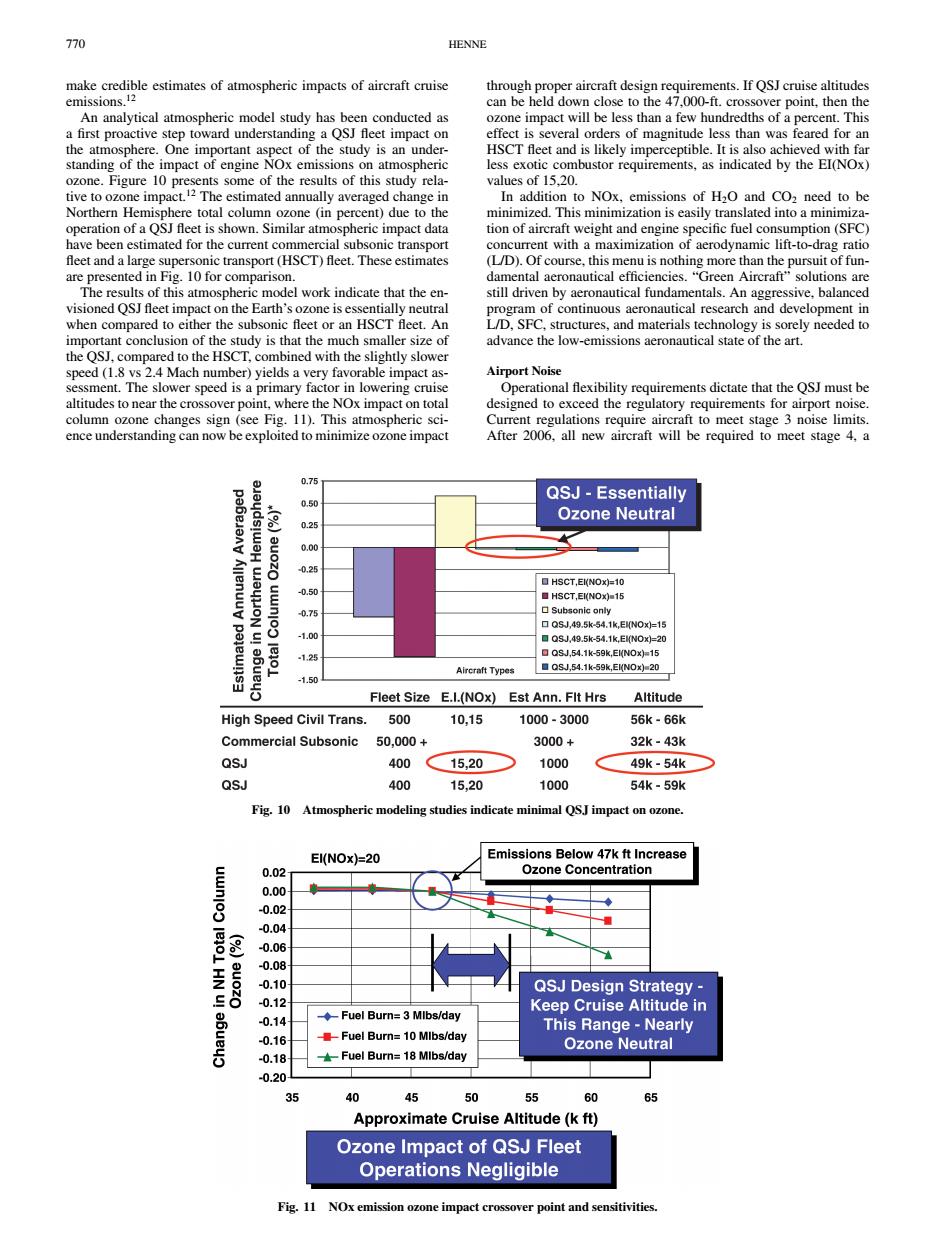正在加载图片...

770 HENNE make credible estimates of atmospheric impacts of aircraft cruise through proper aircraft design requirements.If QSJ cruise altitudes emissions.12 can be held down close to the 47,000-ft.crossover point,then the An analytical atmospheric model study has been conducted as ozone impact will be less than a few hundredths of a percent.This a first proactive step toward understanding a QSJ fleet impact on effect is several orders of magnitude less than was feared for an the atmosphere.One important aspect of the study is an under- HSCT fleet and is likely imperceptible.It is also achieved with far standing of the impact of engine NOx emissions on atmospheric less exotic combustor requirements,as indicated by the EI(NOx) ozone.Figure 10 presents some of the results of this study rela- values of 15.20. tive to ozone impact.2 The estimated annually averaged change in In addition to NOx,emissions of H2O and CO2 need to be Northern Hemisphere total column ozone (in percent)due to the minimized.This minimization is easily translated into a minimiza- operation of a QSJ fleet is shown.Similar atmospheric impact data tion of aircraft weight and engine specific fuel consumption(SFC) have been estimated for the current commercial subsonic transport concurrent with a maximization of aerodynamic lift-to-drag ratio fleet and a large supersonic transport(HSCT)fleet.These estimates (L/D).Of course,this menu is nothing more than the pursuit of fun- are presented in Fig.10 for comparison. damental aeronautical efficiencies."Green Aircraft"solutions are The results of this atmospheric model work indicate that the en- still driven by aeronautical fundamentals.An aggressive,balanced visioned QSJ fleet impact on the Earth's ozone is essentially neutral program of continuous aeronautical research and development in when compared to either the subsonic fleet or an HSCT fleet.An L/D,SFC,structures,and materials technology is sorely needed to important conclusion of the study is that the much smaller size of advance the low-emissions aeronautical state of the art. the QSJ,compared to the HSCT,combined with the slightly slower speed(1.8 vs 2.4 Mach number)yields a very favorable impact as- Airport Noise sessment.The slower speed is a primary factor in lowering cruise Operational flexibility requirements dictate that the QSJ must be altitudes to near the crossover point,where the NOx impact on total designed to exceed the regulatory requirements for airport noise. column ozone changes sign (see Fig.11).This atmospheric sci- Current regulations require aircraft to meet stage 3 noise limits. ence understanding can now be exploited to minimize ozone impact After 2006,all new aircraft will be required to meet stage 4.a 0.75 QSJ-Essentially 0.50 Ozone Neutral 0.25 % 0.25 HsCT,EI(NOx)=10 0.50 ▣HSCT,EINOx)■15 0.75 口Subsonic only 口QSJ,49.5k-54.1k,E0w0x=15 1.00 ▣Q5J,4g.5k-54.1k,EN0x0=20 125 QSJ,54.1k-59k,EI(NOx)=15 Aircraft Types QSJ,54.1k-59k,EI(NOx)=20 -1.50 Fleet Size E.I.(NOx)Est Ann.FIt Hrs Altitude High Speed Civil Trans. 500 10,15 1000-3000 56k-66k Commercial Subsonic 50.000+ 3000+ 32k-43k QSJ 400 15,20 1000 49k-54k QSJ 400 15,20 1000 54k-59k Fig.10 Atmospheric modeling studies indicate minimal QS.J impact on ozone. EI(NOx)=20 Emissions Below 47k ft Increase 0.02 Ozone Concentration uwnlo 0.00 -0.02 0.04 IeoL HN -0.06 -0.08 -0.10 QSJ Design Strategy- -0.12 Keep Cruise Altitude in -0.14 ◆Fuel Burn:=3MIbs/day This Range-Nearly -0.16 -Fuel Burn=10 MIbs/day Ozone Neutral 0.18 Fuel Burn=18 MIbs/day 0.20 35 50 55 % 65 Approximate Cruise Altitude(k ft) Ozone Impact of QSJ Fleet Operations Negligible Fig.11 NOx emission ozone impact crossover point and sensitivities770 HENNE make credible estimates of atmospheric impacts of aircraft cruise emissions.12 An analytical atmospheric model study has been conducted as a first proactive step toward understanding a QSJ fleet impact on the atmosphere. One important aspect of the study is an understanding of the impact of engine NOx emissions on atmospheric ozone. Figure 10 presents some of the results of this study relative to ozone impact.12 The estimated annually averaged change in Northern Hemisphere total column ozone (in percent) due to the operation of a QSJ fleet is shown. Similar atmospheric impact data have been estimated for the current commercial subsonic transport fleet and a large supersonic transport (HSCT) fleet. These estimates are presented in Fig. 10 for comparison. The results of this atmospheric model work indicate that the envisioned QSJ fleet impact on the Earth’s ozone is essentially neutral when compared to either the subsonic fleet or an HSCT fleet. An important conclusion of the study is that the much smaller size of the QSJ, compared to the HSCT, combined with the slightly slower speed (1.8 vs 2.4 Mach number) yields a very favorable impact assessment. The slower speed is a primary factor in lowering cruise altitudes to near the crossover point, where the NOx impact on total column ozone changes sign (see Fig. 11). This atmospheric science understanding can now be exploited to minimize ozone impact Fig. 10 Atmospheric modeling studies indicate minimal QSJ impact on ozone. Fig. 11 NOx emission ozone impact crossover point and sensitivities. through proper aircraft design requirements. If QSJ cruise altitudes can be held down close to the 47,000-ft. crossover point, then the ozone impact will be less than a few hundredths of a percent. This effect is several orders of magnitude less than was feared for an HSCT fleet and is likely imperceptible. It is also achieved with far less exotic combustor requirements, as indicated by the EI(NOx) values of 15,20. In addition to NOx, emissions of H2O and CO2 need to be minimized. This minimization is easily translated into a minimization of aircraft weight and engine specific fuel consumption (SFC) concurrent with a maximization of aerodynamic lift-to-drag ratio (L/D). Of course, this menu is nothing more than the pursuit of fundamental aeronautical efficiencies. “Green Aircraft” solutions are still driven by aeronautical fundamentals. An aggressive, balanced program of continuous aeronautical research and development in L/D, SFC, structures, and materials technology is sorely needed to advance the low-emissions aeronautical state of the art. Airport Noise Operational flexibility requirements dictate that the QSJ must be designed to exceed the regulatory requirements for airport noise. Current regulations require aircraft to meet stage 3 noise limits. After 2006, all new aircraft will be required to meet stage 4, a